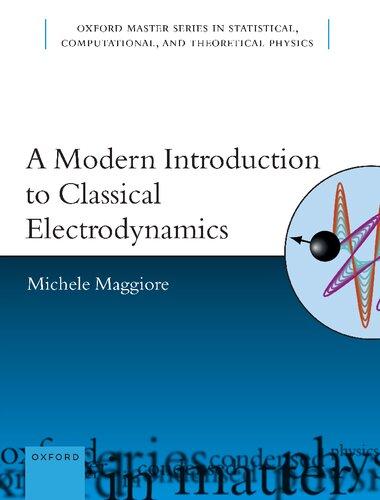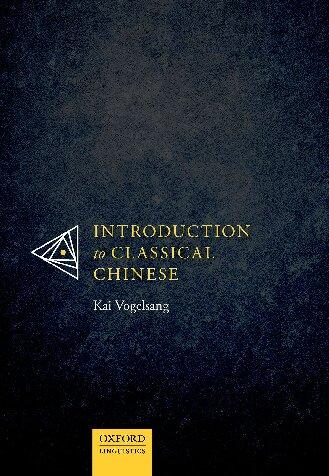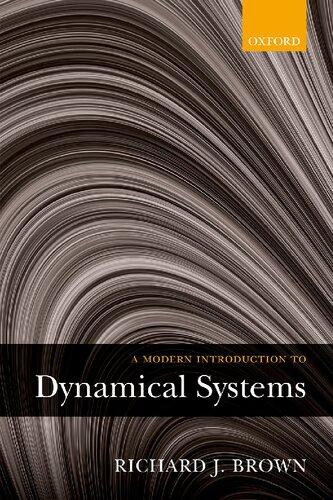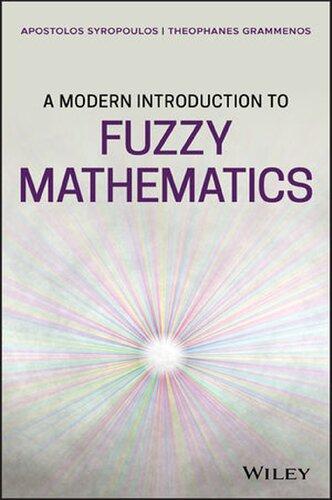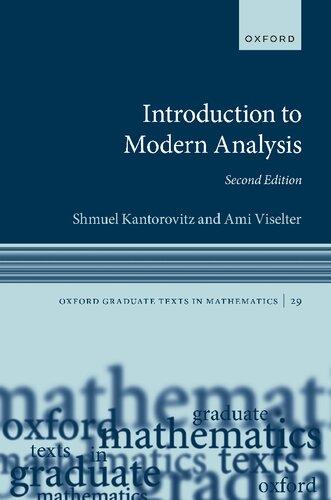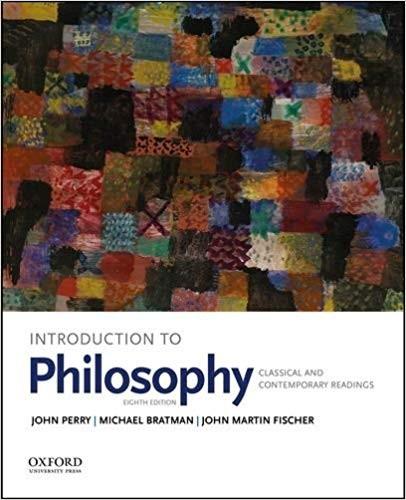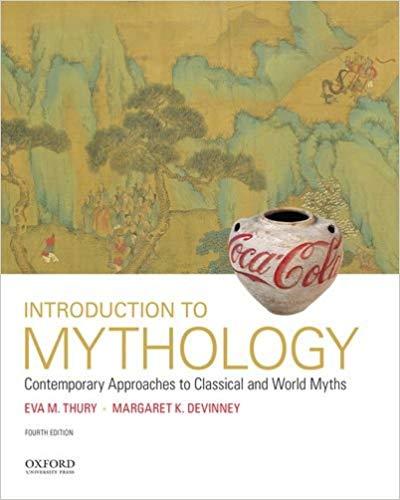A Modern Introduction to Classical Electrodynamics 1st Edition Michele Maggiore Visit to download the full and correct content document: https://ebookmass.com/product/a-modern-introduction-to-classical-electrodynamics-1 st-edition-michele-maggiore/
More products digital (pdf, epub, mobi) instant download maybe you interests ...
Introduction to Classical Chinese Vogelsang
https://ebookmass.com/product/introduction-to-classical-chinesevogelsang/
A Modern Introduction to Dynamical Systems Richard Brown
https://ebookmass.com/product/a-modern-introduction-to-dynamicalsystems-richard-brown/
A Modern Introduction to Fuzzy Mathematics 1. Edition Apostolos Syropoulos
https://ebookmass.com/product/a-modern-introduction-to-fuzzymathematics-1-edition-apostolos-syropoulos/
Introduction to Modern Analysis, 2nd Edition Kantorovitz
https://ebookmass.com/product/introduction-to-modernanalysis-2nd-edition-kantorovitz/
(eBook PDF) Introduction to Philosophy: Classical and Contemporary Readings 8th Edition
https://ebookmass.com/product/ebook-pdf-introduction-tophilosophy-classical-and-contemporary-readings-8th-edition/
(eBook PDF) Introduction to Mythology: Contemporary Approaches to Classical and World Myths 4th Edition
https://ebookmass.com/product/ebook-pdf-introduction-tomythology-contemporary-approaches-to-classical-and-worldmyths-4th-edition/
Introduction to AutoCAD® 2024: A Modern Perspective
Paul Richard
https://ebookmass.com/product/introduction-toautocad-2024-a-modern-perspective-paul-richard/
After Ancient Biography: Modern Types and Classical Archetypes 1st ed. Edition Robert Fraser
https://ebookmass.com/product/after-ancient-biography-moderntypes-and-classical-archetypes-1st-ed-edition-robert-fraser/
A Gendered Lens for Genocide Prevention 1st Edition
Mary Michele Connellan
https://ebookmass.com/product/a-gendered-lens-for-genocideprevention-1st-edition-mary-michele-connellan/
A MODERNINTRODUCTIONTOCLASSICALELECTRODYNAMICS OXFORD MASTER SERIES IN PHYSICS
TheOxfordMasterSeriesisdesignedforfinalyearundergraduateandbeginninggraduatestudentsinphysicsandrelated disciplines.Ithasbeendrivenbyaperceivedgapintheliteraturetoday.Whilebasicundergraduatephysicstextsoftenshow littleornoconnectionwiththehugeexplosionofresearchoverthelasttwodecades,moreadvancedandspecializedtexts tendtoberatherdauntingforstudents.Inthisseries,alltopicsandtheirconsequencesaretreatedatasimplelevel,while pointerstorecentdevelopmentsareprovidedatvariousstages.Theemphasisisonclearphysicalprincipleslikesymmetry, quantummechanics,andelectromagnetismwhichunderliethewholeofphysics.Atthesametime,thesubjectsarerelated torealmeasurementsandtotheexperimentaltechniquesanddevicescurrentlyusedbyphysicistsinacademeandindustry. Booksinthisseriesarewrittenascoursebooks,andincludeampletutorialmaterial,examples,illustrations,revisionpoints, andproblemsets.Theycanlikewisebeusedaspreparationforstudentsstartingadoctorateinphysicsandrelatedfields, orforrecentgraduatesstartingresearchinoneofthesefieldsinindustry.
CONDENSED MATTER PHYSICS 1.M.T.Dove: Structureanddynamics:anatomicviewofmaterials
2.J.Singleton: Bandtheoryandelectronicpropertiesofsolids
3.A.M.Fox: Opticalpropertiesofsolids,secondedition
4.S.J.Blundell: Magnetismincondensedmatter
5.J.F.Annett: Superconductivity,superfluids,andcondensates
6.R.A.L.Jones: Softcondensedmatter
17.S.Tautz: Surfacesofcondensedmatter
18.H.Bruus: Theoreticalmicrofluidics
19.C.L.Dennis,J.F.Gregg: Theartofspintronics:anintroduction
21.T.T.Heikkilä: Thephysicsofnanoelectronics:transportandfluctuationphenomenaatlowtemperatures
22.M.Geoghegan,G.Hadziioannou: Polymerelectronics
ATOMIC,OPTICAL, AND LASER PHYSICS
7.C.J.Foot: Atomicphysics
8.G.A.Brooker: Modernclassicaloptics
9.S.M.Hooker,C.E.Webb: Laserphysics
15.A.M.Fox:Quantumoptics: anintroduction
16.S.M.Barnett: Quantuminformation
23.P.Blood: Quantumconfinedlaserdevices
PARTICLE PHYSICS,ASTROPHYSICS, AND COSMOLOGY
10.D.H.Perkins: Particleastrophysics,secondedition
11.Ta-PeiCheng: Relativity,gravitationandcosmology,secondedition
24.G.Barr,R.Devenish,R.Walczak,T.Weidberg: ParticlephysicsintheLHCera
26.M.E.Peskin: Conceptsofelementaryparticlephysics
STATISTICAL,COMPUTATIONAL, AND THEORETICAL PHYSICS
12.M.Maggiore: Amodernintroductiontoquantumfieldtheory
13.W.Krauth: Statisticalmechanics:algorithmsandcomputations
14.J.P.Sethna: Statisticalmechanics:entropy,orderparameters,andcomplexity,secondedition
20.S.N.Dorogovtsev: Lecturesoncomplexnetworks
25.R.Soto: Kinetictheoryandtransportphenomena
27.M.Maggiore: Amodernintroductiontoclassicalelectrodynamics
A ModernIntroductiontoClassicalElectrodynamics MicheleMaggiore
DépartementdePhysiqueThéorique
UniversitédeGenève
GreatClarendonStreet,Oxford,OX26DP, UnitedKingdom
OxfordUniversityPressisadepartmentoftheUniversityofOxford. ItfurtherstheUniversity’sobjectiveofexcellenceinresearch,scholarship, andeducationbypublishingworldwide.Oxfordisaregisteredtrademarkof OxfordUniversityPressintheUKandincertainothercountries ©MicheleMaggiore2023
Themoralrightsoftheauthorhavebeenasserted Allrightsreserved.Nopartofthispublicationmaybereproduced,storedin aretrievalsystem,ortransmitted,inanyformorbyanymeans,withoutthe priorpermissioninwritingofOxfordUniversityPress,orasexpresslypermitted bylaw,bylicenceorundertermsagreedwiththeappropriatereprographics rightsorganization.Enquiriesconcerningreproductionoutsidethescopeofthe aboveshouldbesenttotheRightsDepartment,OxfordUniversityPress,atthe addressabove
Youmustnotcirculatethisworkinanyotherform andyoumustimposethissameconditiononanyacquirer
PublishedintheUnitedStatesofAmericabyOxfordUniversityPress 198MadisonAvenue,NewYork,NY10016,UnitedStatesofAmerica
BritishLibraryCataloguinginPublicationData Dataavailable
LibraryofCongressControlNumber:2023935108
ISBN9780192867421
ISBN9780192867438(pbk.)
DOI:10.1093/oso/9780192867421.001.0001
Printedandboundby
CPIGroup(UK)Ltd,Croydon,CR04YY
LinkstothirdpartywebsitesareprovidedbyOxfordingoodfaithand forinformationonly.Oxforddisclaimsanyresponsibilityforthematerials containedinanythirdpartywebsitereferencedinthiswork.
AMaura,Sara,IlariaeLorenzo
Preface ThisbookevolvedfromthenotesofacoursethatIteachattheUniversityofGeneva,forundergraduatephysicsstudents.Formanygenerationsofphysicists,includingmine,theclassicreferencesforclassical electrodynamicshavebeenthetextbookbyJacksonandthatbyLandauandLifschits.1 Theformerisstillmuchused,althoughmoremodern
1Inthetextwewillrefertothelatest editionsofthesebooks,Jackson(1998) andLandauandLifschits(1975).However,thesebookswentthroughmany editions:thefirsteditionofJacksonappearedin1962,whilethatofLandau andLifschitsevendatesbackto1939. andexcellenttextbookswithasomewhatsimilarstructure,suchasGarg (2012)orZangwill(2013),nowexist,whilethelatterisbynowrarely used,evenasanauxiliaryreferencetextforacourse.Becauseofmy field-theoreticalbackground,asmynotesweregrowingIrealizedthat theywerenaturallydriftingtowardwhatlookedtomeasamodernversionofLandauandLifschits,andthisstimulatedmetoexpandthem furtherintoabook.
Whilethisbookismeantasamodernintroductiontoclassicalelectrodynamics,itisbynomeansintendedasafirstintroductiontothe subject.Thereaderisassumedtohavealreadyhadafirstcourseon electrodynamics,atalevelcoveredforinstancebyGriffiths(2017).This alsoimpliesadifferentstructureofthepresentation.Inafirstcourse ofelectrodynamics,itisnaturaltotakea‘bottom-up’approach,where onestartsfromexperimentalobservationsinthesimplesettingsofelectrostaticsandmagnetostatics,andthenmovestowardtime-dependent phenomenaandelectromagneticinduction,whicheventuallyleadsto generalizingtheequationsgoverningelectrostaticsandmagnetostatics intothesynthesisprovidedbythefullMaxwell’sequation.Thisapproachisthenaturaloneforafirstintroductionbecause,firstofall, givesthecorrecthistoricalperspectiveandshowshowMaxwell’sequationsemergedfromtheunificationofalargebodyofobservations;furthermore,italsoallowsonetostartwithmoreelementarymathematical tools,forthebenefitofthestudentthatmeetssomeofthemforthefirst time,whileatthesametimediscoveringallthesenewandfundamental physicsconcepts.Thepricethatispaidisthattheapproach,following thehistoricaldevelopments,issometimesheuristic,andthelogicofthe argumentsandderivationsisnotalwaystight.
Forthismoreadvancedtext,Ihavechoseninsteada‘top-down’approach.Maxwell’sequationsareintroducedimmediately(afteranintroductorychapteronmathematicaltools)asthe‘definition’ofthetheory, andtheirconsequencesarethensystematicallydeveloped.Thishasthe advantageofabetterlogicalclarity.Itwillalsoallowustoalwaysgo intothe‘realstory’,ratherthanpresentingatfirstasimplerversion,to belaterimproved.
22 Thisapproachisdifferentfrom,e.g. thatofJackson,orZangwill.Itis insteadthesamefollowedbyGarg, andespeciallybyLandauandLifschits,thatevenseparatedthesubjects intotwodifferentbooks:“TheClassicalTheoryofFields”,Landauand Lifschits(1975),forvacuumelectrodynamics,and“ElectrodynamicsofContinuousMedia”,LandauandLifschits (1984)forelectrodynamicsinmaterials.
Animportantaspectofourpresentationisthatwekeepdistinctthe discussionofelectrodynamics‘invacuum’(i.e.,thecomputationofthe electromagneticfieldsgeneratedbylocalizedsources,intheregionoutsidethesources)fromthestudyofMaxwell’sequationsinsidematerials.Thestudyoftheequations‘invacuum’revealstheunderlying fundamentalstructureofthetheory,whileclassicalelectrodynamicsin materialmediaisbasicallyaphenomenologicaltheory.Mixingthetwo treatments,becauseofaformalsimilarityamongtheequations,canbe conceptuallyconfusing.UntilChapter12wewillfocusuniquelyonvacuumelectrodynamics,whilefromChapter13westudyelectrodynamics inmaterials.
3
Bycomparison,Jacksonintroduces thegaugepotentialsinfullgeneralityforthefirsttimeonlyafterabout 220pagesandZangwillafterabout500 pages,andtheirintroductionisingeneralpresentedsimplyasatrickforsimplifyingtheequations.However,their roleismuchmorefundamental,since theyarethebasicdynamicalvariables inafield-theoreticaltreatment(which alsoimpliesthattheywillbecomethe basicvariablesalsowhenonemovesto aquantumtreatment).AsforSpecial Relativity,Jacksonintroducesitonly aftermorethan500pages,whileZangwillrelegatesittoChapter22,after820 pages,andGargtoChapter24.
Focusingfirstonvacuumelectrodynamicsallowsustobringoutthe twomostimportantstructuralaspectsofthetheoryatitsfundamental level,namelygaugeinvarianceandthefactthatSpecialRelativityis hiddenintheMaxwell’sequations.Wewillintroduceimmediatelyand infullgeneralitythegaugepotentials,andworkoutmostoftheequationsandderivationsofvacuumelectrodynamicsintermsofthem.From amodernfield-theoreticalperspective,weknowthatclassicalelectrodynamicsistheprototypeofagaugetheory,andthenotionofgaugefields andgaugeinvarianceiscentraltoallmodernparticlephysics,aswellas tocondensedmattertheory.Similarly,afterhavingdulyderivedfrom Maxwell’sequationsthemostelementaryresultsofelectrostaticsand magnetostatics,aswellasthenotionsofworkandelectromagneticenergyandtheexpansioninstaticmultipoles,wemoveasfastaspossible toSpecialRelativity,introducingthecovariantformalismandshowing howMaxwell’sequationscanbereformulatedinacovariantform.3 Hav-
inginourhandsthegaugepotentialsandthecovariantformalism,most ofthesubsequentderivationsinChapters8–12areperformedinterms ofthem,withaclearadvantageintechnicalandconceptualclarity. Evenifthisbookwasbornfrommynotesforanundergraduatecourse, andismeanttobeusedforsuchacourse,ithasobviouslygrownwell beyondtheoriginalscope,andsomepartsofitarequiteadvanced. Moretechnicalsections,orwholechaptersthataremorespecialized, areclearlymarked,sothatthebookcanbeusedatdifferentlevels, fromtheundergraduatestudent,totheresearcherthatneedstochecka textbookasareference.Classicalelectrodynamics,foritsrichnessand importance,isasubjecttowhichonereturnsoverandoverduringa scientist’scareer.
Finally,animportantpoint,whenwritingatextbookofelectrodynamics,isthechoiceofthesystemofunits.Inmechanics,thetransformationbetweensystemssuchasc.g.s.(centimeter-gram-second)andm.k.s. (meter-kilogram-second)istrivial,andjustamountstomultiplicative factors.However,inelectromagnetismtherearefurthercomplications. Thishasledtotwomainsystemsofunitsforclassicalelectrodynamics: theSIsystem,andtheGaussiansystem.AswewilldiscussinChapter2, theessentialdifferenceisthat,forelectromagnetism,theSIsystembesidetheunitsoflength,massandtime,introducesafourthindependent baseunitofcurrent,theampere,whileintheGaussiansystemtheunit
ofcharge,andthereforeofcurrent,isderivedfromthethreebasicunits oflength,massandtime.
TheSIsystemisthenaturaloneforapplicationstothemacroscopic world:currentsaremeasuredinamperes,voltagesinvolts,andsoon. ThismakestheSIsystemtheobviouschoiceforlaboratoryapplications andinelectricalengineering,andSIunitsarebynowthealmostuniversalstandardforelectrodynamicscoursesattheundergraduatelevel. TheGaussiansystem,ontheotherhand,hasadvantagesinothercontexts,andinparticularleadstoneaterformulaswhenrelativisticeffects areimportant.4
Thisstateofaffairshasledtoaratherpeculiarsituation.Ingeneral, undergraduatetextbooksofclassicalelectromagnetismalwaysuseSI units;incontrast,moreadvancedtextbooksofclassicalelectrodynamics areoftensplitbetweenSIandGaussianunits,andalltextbookson quantumelectrodynamicsandquantumfieldtheoryuseGaussianunits. ThedifficultyofthechoiceisexemplifiedbytheJackson’stextbook, thathasbeenthe‘bible’ofclassicalelectrodynamicsforgenerationsof physicists.Thesecondedition(1975),asthefirst,usedGaussianunits throughout.However,thethirdedition(1998)switchedtoSIunitsfor thefirst10chapters,inrecognitionofthefactthatalmostallother undergraduateleveltextbooksusedSIunits;then,fromChapter11 (SpecialTheoryofRelativity)on,itgoesbacktoGaussianunits,in recognitionofthefactthattheyaremoreappropriatethanSIunits forrelativisticphenomena.5 Gaussianunitsarealsothemostcommon
choiceinquantummechanicstextbooks:whencomputingtheenergy levelofthehydrogenatom,almostalltextbooksuseaCoulombpotential inGaussianunits, e2/r,ratherthantheSIexpression e2/(4π 0r).6
InthisbookwewilluseSIunits,sincethisisnowadaysthealmost universalstandardforanundergraduatetextbookonclassicalelectrodynamics.However,itisimportanttobefamiliaralsowiththeGaussian system,asabridgetowardgraduateandmorespecializedcourses.This isparticularlyimportantforthestudentthatwishestogointotheoreticalhigh-energyphysicswhere,eventually,onlytheGaussiansystem willbeused.WewillthendiscussinSection2.2howtoquicklytranslatefromSItoGaussianunits,and,inAppendixA,wewillprovidean explicittranslationinGaussianunitsofthemostimportantresultsand formulasofthemaintext.
Finally,IwishtothankEnisBelgacem,FrancescoIacovelliandMichele Mancarella,whogavetheexercisesessionsofthecourseforvariousyears, andStefanoFoffaforusefuldiscussions.IthankagainFrancescoIacovelli forproducingaverylargenumberoffiguresofthebook.Iamgrateful toStephenBlundellforextremelyusefulcommentsonthemanuscript. Lastbutnotleast,aswithmypreviousbookswithOUP,Iwishtothank SonkeAdlung,forhisfriendlyandalwaysveryusefuladvice,aswellas allthestaffatOUP.
Geneva,January2023
4Actually,itsrealvirtuesappear whencombiningelectromagnetismwith quantummechanics.Inthiscase,the reductionfromfourtothreebaseunits obtainedwiththeGaussiansystemcan bepushedfurther,usingasystemof unitswhereonealsosets = c =1, withtheresultthatoneremainswitha singlebaseunit,typicallytakentobe themassunit.Inquantumfieldtheorythissystemissoconvenientthat units = c =1arecalled naturalunits (wewillbrieflymentiontheminSection2.2).Asaconsequence,allgeneralizationsfromclassicalelectrodynamics toquantumelectrodynamics(andits extensionssuchastheStandardModel ofelectroweakandstronginteractions) arenowadaysuniquelydiscussedusing theGaussiansystem(or,rather,avariantofit,Heaviside–LorentzorrationalizedGaussianunits,differingjustby theplacingofsome4π factors,thatwe willalsointroduceinChapter2),supplementedbyunits = c =1.
5Amongtheother‘old-time’classics, LandauandLifschits(1975)usedGaussianunits,whiletheFeynmanLectures onPhysics,Feynman etal. (1964),used SI.ThefirsttwoeditionsoftheclassictextbookbyPurcellusedGaussian units,butswitchedtoSIforthe3rdedition,PurcellandMorin(2013).Among morerecentbooks,SIisusedinGriffiths(2017),Zangwill(2013)andTong (2015),whileGaussianunitsareusedin Garg(2012)(withfrequenttranslations toSIunits).
6Themostnotableexceptionisthe quantummechanicstextbookGriffiths (2004),thatusesSIunits,consistently withtheclassicalelectrodynamicsbook bythesameauthor.
1Mathematicaltools1
1.1Vectoralgebra
1.2Differentialoperatorsonscalarandvectorfields
1.3Integrationofvectorfields.Gauss’sandStokes’stheorems 5
1.5Fouriertransform
1.6Tensorsandrotations
1.7Groupsandrepresentations
1.7.1Reducibleandirreduciblerepresentations
1.7.2Therotationgroupanditsirreducibletensorrepresentations
2Systemsofunits27 2.1TheSIsystem
3Maxwell’sequations39
3.1Maxwell’sequationsinvectorform
3.1.1LocalformofMaxwell’sequations
3.1.2IntegratedformofMaxwell’sequations
3.2Conservationlaws
3.2.1Conservationoftheelectriccharge
3.2.2Energy,momentum,andangularmomentumof theelectromagneticfield
3.3Gaugepotentialsandgaugeinvariance
4ElementaryapplicationsofMaxwell’sequations57
4.1Electrostatics
4.1.1Coulomb’slaw
4.1.2Electricfieldfromagenericstaticchargedensity
4.1.3Scalargaugepotentialandelectrostaticpotential
4.1.4Instabilityofasystemofstaticcharges
4.1.5Uniquenessofthesolutionofelectrostaticproblems
4.1.6Electrostaticsofconductors
4.1.7Electrostaticforcesfromsurfaceintegrals
4.2Magnetostatics
4.2.1Magneticfieldofaninfinitestraightwire
4.2.2Magneticfieldofastaticcurrentdensity
4.2.3Forceofamagneticfieldonawireandbetween twoparallelwires
4.3.1Time-varyingmagneticfieldandLenz’slaw
6.4.2Interactionbetweentheelectricmultipolesoftwo chargedistributions
7.2.1Lorentztransformations
7.2.2Causalityandsimultaneity
7.2.3Propertimeandtimedilatation
7.2.4Lorentzcontraction
7.3.1Four-vectorsandLorentztensors
7.3.2Contravariantandcovariantquantities
7.3.3InvarianttensorsoftheLorentzgroup
7.3.4InfinitesimalLorentztransformations
7.3.5DecompositionofaLorentztensorunderrotations
7.3.6Covarianttransformationsoffields 173
7.3.7Moregenerallessons 177
7.4Relativisticparticlekinematics 177
7.4.1Covariantdescriptionofparticletrajectories 177
7.4.2Actionofafreerelativisticparticle 179
7.4.3Relativisticenergyandmomentum 180
8Covariantformulationofelectrodynamics183
8.1Thefour-vectorcurrent 183
8.2Thefour-vectorpotential Aµ andthe Fµν tensor 185
8.3CovariantformofMaxwell’sequations 186
8.4Energy-momentumtensoroftheelectromagneticfield 188
8.5Lorentztransformationsofelectricandmagneticfields 190
8.6Relativisticformulationoftheparticle-fieldinteraction 192
8.6.1CovariantformoftheLorentzforceequation 192
8.6.2Theinteractionactionofapointparticle 194
8.7Field-theoreticalapproachtoclassicalelectrodynamics 197
8.7.1Euler–Lagrangeequationsofrelativisticfields 197
8.7.2Lagrangianoftheelectromagneticfield 202
8.7.3Noether’stheorem 205
8.8Solvedproblems 211
9Electromagneticwavesinvacuum217
9.1Waveequations 217
9.2ElectromagneticwavesintheLorenzgauge 219
9.3ElectromagneticwavesintheCoulombgauge 222
9.4Solutionsfor E and B 224
9.5Polarizationoflight 228
9.6Dopplereffectandlightaberration 229
10Electromagneticfieldofmovingcharges235
10.1AdvancedandretardedGreen’sfunction 235
10.2TheLi´enard–Wiechertpotentials 242
10.3Fieldsofchargeinuniformmotion 245
10.4Radiationfieldfromacceleratedcharges 249
10.5Radiationfromnon-relativisticcharges.Larmorformula 252
10.6Powerradiatedbyrelativisticsources 256
10.6.1RelativisticgeneralizationofLarmor’sformula 256
10.6.2Accelerationparalleltothevelocity 260
10.6.3Accelerationperpendiculartothevelocity 262
10.7Solvedproblems 264
11Radiationfromlocalizedsources269
11.1Farzonefieldsforgenericvelocities 269
11.1.1ComputationintheLorenzgauge 269
11.1.2ComputationintheCoulombgauge 273
11.1.3Radiatedpowerandspectraldistribution 275
11.2Low-velocitylimitandmultipoleexpansionoftheradiationfield 278
11.2.1Electricdipoleradiation
v/c)2
12.2.1Thegaugepotentialsto1PNorder
tionschemes
Mathematicaltools 1 Classicalelectrodynamicsrequiresagoodfamiliaritywithasetofmathematicaltools,whichwillthenfindapplicationsbasicallyeverywherein physics.Wefinditconvenienttobeginbyrecallingsomeoftheseconceptssothat,later,theunderstandingofthephysicswillnotbeobscured bythemathematicalmanipulations.Wewillfocushereontoolsthatwill beofmoreimmediateuse.Furthermathematicaltoolswillbediscussed alongtheway,intherestofthebook,astheywillbeneeded.
1.1Vectoralgebra Avector a hasCartesiancomponents ai.Weusetheconventionthat repeatedindicesaresummedover,so, a b = i aibi ≡ aibi , (1.1)
wherethesumrunsover i =1, 2, 3inthreespatialdimensions,aswewill assumenext,or,moregenerally,over i =1,...,d in d spatialdimensions. Wecanintroducethe“Kroneckerdelta” δij ,whichisequalto1if i = j andzerootherwise.Notethat,withtheconventionofthesumover repeatedindices,wehavetheidentity
Then,wecanalsorewrite
Fromthedefinitionitfollowsthat,inthreedimensions, δii =3.Note that δij arejustthecomponentsofthe3×3identitymatrix I, δij =(I)ij and δii isthetraceofthe3 × 3identitymatrix(or,in d dimensions, δij arethecomponentsofthe d × d identitymatrix,and δii = d).
Whenusingtheconventionofsummingoverrepeatedindices,one mustbecarefulnottousethesamedummyindexfordifferentsummations.Forexample,writingthesumsexplicitly, (a b)(c d)= 3
Withtheconventionofthesumoverrepeatedindices,theright-hand sidebecomes aibicj dj .Noticethatitwasimportantheretousetwo differentletters, i,j,forthedummyindicesinvolved.
1.1 Vectoralgebra1
1.2 Differentialoperatorson scalarandvectorfields3 1.3 Integrationofvectorfields. Gauss’sandStokes’s theorems5
1.4 Diracdelta7
1.5 Fouriertransform13
1.6 Tensorsandrotations16
1.7 Groupsandrepresentations 18
Thevectorproductisgivenby
where ijk isthetotallyantisymmetrictensor(ortheLevi–Civitatensor),definedby 123 =+1,togetherwiththeconditionthatitisantisymmetricunderanyexchangeofindices.Therefore ijk =0iftwo indiceshavethesamevalueand,e.g., 213 = 123 = 1.Thisalso impliesthatthetensoriscyclic, ijk = jik = jki,i.e.,itisunchanged underacyclicpermutationoftheindices.Notethat a × b = b × a. WewillseeinSection1.6thatthetensors δij and ijk playaspecialrole inthetheoryofrepresentationsoftherotationgroup.Unitvectorsare denotedbyahat;forinstance, ˆ x, ˆ y,and ˆ z aretheunitvectorsalong the x,y and z axes,respectively.Notethat,e.g.,
Averyusefulidentityis
(Proveit!)Notethestructureoftheindices:ontheleft,theindex i is summedover,soitdoesnotappearontheright-handside.Itisadummy index,andwecouldhaveusedadifferentnameforit.Forinstance,the left-handsideofeq.(1.7)couldbewrittenas pjk plm,withadifferent letter p.Incontrast,theindices j,k,l,m arefreeindicesso,ifthey appearontheleft-handside,theymustalsoappearontheright-hand side.Notealsothat,becauseofthecyclicpropertyoftheepsilontensor, theleft-handsideofeq.(1.7)canalsobewrittenas jki ilm.
Exercise1.1 Showthat
Exercise1.2 Usingeq.(1.7),showthat
Observethatthevectorproductisnotassociative:ingeneral, a×(b×c) isdifferentfrom(a × b) × c
Exercise1.3 Usingeq.(1.7),showthat
Double-checktheresultbydirectlyidentifyingthecombinationsofindicesthatgiveanon-zerocontributionstotheleft-handsideofeq.(1.11).
1.2Differentialoperatorsonscalarand vectorfields Wewillusethenotation ∂i = ∂/∂xi forthepartialderivativewith respecttotheCartesiancoordinates xi.Then,if f (x)isafunctionofthe spatialcoordinates,itsgradient ∇f isavectorfield(i.e.,avectordefined ateachpointofspace)whosecomponents,inCartesiancoordinates,are givenby
(∇f )i = ∂if (gradientofascalarfunction) , (1.12) or,invectorform,
∇f =(∂xf )ˆ x +(∂y f )ˆ y +(∂z f )ˆ z . (1.13)
Theexpressioninpolarcoordinates(r,θ,φ)canbeobtainedbyperformingexplicitlythetransformationbetweenthederivatives ∂x,∂y ,∂z and thederivatives ∂r = ∂/∂r,∂θ = ∂/∂θ ,and ∂φ = ∂/∂φ,andexpressing ˆ x, ˆ y, ˆ z intermsoftheunitvectors ˆ r, ˆ θ, ˆ φ (andsimilarlyinanyothercoordinatesystem,suchascylindricalcoordinates);wewillgivetheresults inpolaradcylindriccoordinatesfordifferentoperatorsattheendofthis section.Givenavectorfield v(x),wecanformtwonotablequantities withtheactionof ∇:thedivergence
∇·v = ∂ivi (divergenceofavectorfield) , (1.14) whichisascalarfield(i.e.,aquantityinvariantunderrotations,defined ateachpointofspace),andthecurl, ∇ × v,whichisagainavector field,withCartesiancomponents
(∇ × v)i = ijk∂j vk (curlofavectorfield) (1.15)
Givenafunction f ,afterformingthevectorfield ∇f ,wecanobtain againascalarbytakingthedivergenceof ∇f .ThisdefinestheLaplacian ∇2 , ∇2f = ∇ (∇f ),or ∇2f = ∂i∂if =(
2 x +
2
+
2 z )f, (1.16) where ∂x = ∂/∂x,etc.Similarly,wecandifferentiatefurtherthedivergenceorthecurlofavectorfield.Forinstance, ∇(∇·v)isavectorfield withcomponents
[∇(∇ v)]i = ∂i∂j vj , (1.17) while ∇·(∇ × v)isascalarfield,sinceitisthedivergenceofavector field.However,fromtheexplicitcomputationincomponents,
∇ (∇ × v)= ∂i( ijk∂j vk) = ijk∂i∂j vk =0 . (1.18)
1Ourconventiononthepolaranglesis suchthatsphericalcoordinatesarerelatedtoCartesiancoordinatesby x = r sin θ cos φ, y = r sin θ sin φ, z = r cos θ,with θ ∈ [0,π]and φ ∈ [0, 2π].
Cylindricalcoordinatesarerelatedto Cartesiancoordinatesby x = ρ cos ϕ, y = ρ sin ϕ (with ϕ ∈ [0, 2π])and z = z. Then,as ϕ increases,werotatecounterclockwisewithrespecttothe z axis. Thismeansthat ˆ ρ× ˆ ϕ =+ˆ z
2TheLaplacianofavectorfieldhas beendefinedfromeq.(1.20)intermsof theCartesiancoordinatesand,inthis case,oneachcomponentofthevectorfield,ithasthesameformasthe Laplacianactingonascalar.Thisisno longertrueinpolarofcylindricalcoordinates.Inthatcase, ∇2v canbemore easilyobtainedfromeq.(1.21),using thecorrespondingexpressionsof ∇ v and ∇ × v.
Thelastequalityfollowsbecause ∂i∂j isanoperatorsymmetricinthe (i,j)indices(wealwaysassumethatthederivativesactonfunctions, oronvectorfields,thatarecontinuousandinfinitelydifferentiableeverywhere,sothederivativescommute, ∂i∂j = ∂j ∂i),andthereforeit giveszerowhencontractedwiththeantisymmetrictensor ijk.Thus, thegradientofacurlvanishes.Similarly,thecurlofagradientvanishes:
(1.19) againbecause ∂j ∂k issymmetricin(j,k).TheLaplacianofavector fieldisdefined,usingCartesiancoordinates,as
Exercise1.4 Usingeq.(1.7),showthat
Forfuturereference,wegivetheexpressionofthegradientandLaplacianofascalarfield,andofthedivergenceandcurlofavectorfield, inCartesiancoordinates(x,y,x),inpolarcoordinates(r,θ,φ),andin cylindricalcoordinates(ρ,ϕ,z).1,2 Denotingby {ˆ x, ˆ y, ˆ z}, {ˆ
,
},and
,respectively,theunitvectorsinthecorrespondingdirections, wehave
1.3Integrationofvectorfields.Gauss’s andStokes’stheorems Givenavectorfield v(x)andacurve C,onecandefinethelineintegral C d v , (1.34) bybreakingthecurveoverinfinitesimalsegments,andintroducing,in eachsegment,avector d oflength d ,tangenttothecurve.Noticethat thelineintegraldefinedinthiswayisascalarquantity.Ifthecurve C isclosed,thelineintegral(1.34)isknownasthe circulation of v around thecurve.Foraclosedcurve,wewilldenotethelineintegralby d
Theintegraloveratwo-dimensionalsurface S canbedefinedsimilarly. Wesplitthesurfaceininfinitesimalsurfaceelementsofarea ds, 3 and 3Whenwewanttostressthatthisis atwo-dimensionalsurfaceelement,we willwriteitas d2s.Otherwise,tosimplifythenotation,wewritesimply ds
wedefine ds asthevectorofmodulus ds,pointinginthedirectionperpendiculartothesurfaceelement(foraclosedsurface,theconvention istochoosetheoutwardnormal,otherwiseachoiceoforientationmust bemade).Writingtheunitvectornormaltothesurfaceas ˆ n,wehave ds = ˆ n ds.Thesurfaceintegralofavectorfield v(x)isthengivenby
Foraclosedsurface,thisdefinesthe flux of v through S.Inthecaseof aclosedsurface,wewilldenotethesurfaceintegralby ds
Thefundamentaltheoremofcalculusstatesthat,forafunctionofa singlevariable x,
Thiscanbegeneralizedtothelineintegralofafunctionofthethreedimensionalvariable x:fromthedefinitionofthelineintegral(1.34) onecanshow(doit!)that,forafunction f (x)integratedoveracurve C withendpoints x1 and x2,
∇f = f (x2) f (x1) .
Noteinparticularthat,if C isclosed,thelineintegralofagradient vanishes.Stokes’stheoremandGauss’stheoremaregeneralizationsof eq.(1.37)tosurfacesandtovolumes,respectively.Inparticular,let C bea closed curveandlet S be any surfacethathas C asitsboundary (i.e., ∂S = C,wherethenotation ∂S standsfortheboundaryof S). Then,Stokes’stheoremassertsthat,foravectorfield v(x)(withour usualassumptionsofdifferentiability,thatwewillnotrepeatfurther), S ds (∇ × v)= C d v (Stokes’stheorem) (1.38)
Theorientationconventionisthat,ifwegoaroundtheloop C inthe directionofthelineintegral,thenormalto S isobtainedwiththerighthandrule.
Anotherusefulidentityisobtainedbysetting,inStokes’stheorem, v(x)= ψ(x)w,where w isaconstantvector.Then,(∇ × v)i = ijk(∂j ψ)wk andeq.(1.38)becomes
Sincethisisvalidforgeneric w,weget
or,invectornotation,
YetanotherusefulidentityfollowingfromStokes’stheoremisobtained bysetting v(
)= u(x)×w,where,again, w isaconstantvector.Then,
where,inthelastline,weusedeq.(1.7).Theneq.(1.38)gives
andtherefore
Ausefulapplicationofthisformulaisobtainedchoosing ui(x)= xi Then ∂kui = δik and ∂iui =3,soeq.(1.44)gives
However,foraplanarsurface
where A istheareaofthesurfaceand ˆ n istheunitvectornormalto it.Wethereforeobtainanelegantformulaforthearea A ofaplanar surface S,boundedbyacurve C,
Gauss’stheoremextendsStokes’stheoremfurther,tointegrationover volumes:let V beafinitevolumeboundedbythesurface S,i.e., ∂V = S Then,
WewillmakeuseveryoftenofbothGauss’sandStokes’stheorems.44ProceedingasforStokes’stheorem,if weset v(
Avectorfieldsuchthat ∇ × v =0everywhereiscalled irrotational, orcurl-free.Wehaveseenineq.(1.19)that,if v isthegradientofa function, v = ∇f ,thenitisirrotational.Asortofconverseofthis statementholds:
Theoremforcurl-freefields.Let v beavectorfieldsuchthat ∇ × v =0everywhereinaregion V simplyconnected(i.e.,suchthat everyloopin V canbecontinuouslyshrunktoapoint).Then,there existsafunction f suchthat v = ∇f
Avectorfield v suchthat ∇·v =0iscalled solenoidal,ordivergencefree.Similarly,thereisasortofinversetoeq.(1.18):
Theoremfordivergence-freefields.Let v beavectorfieldsuch that ∇·v =0everywhereinavolume V suchthateverysurfacein V canbecontinuouslyshrunktoapoint.Then,thereexistsavectorfield w suchthat v = ∇ × w.
1.4Diracdelta TheDiracdeltaisanespeciallyusefulmathematicalobject,thatappears everywhereinphysics.Physically,itcanbeseenasthemodelizationof apoint-likeobject.TheDiracdelta δ(x)isnotafunctionintheproper sense.Rather,inonedimension,itisdefinedfromtheconditionsthat
δ(x x0)=0if x = x0 , (1.51) andthat,foranyfunction f (x)regularinanintegrationregion I that includes x0,
(x x0)f (x)= f (x0) . (1.52)
Notethattheintegralontheleft-handsidevanishesif I doesnotinclude x0 becauseofeq.(1.51)[andoftheassumedregularityof f (x)].Onthe otherhand,againbecauseofeq.(1.51),theintegralintheleft-handside ofeq.(1.52)isindependentof I,aslongas x0 ∈ I.Inthefollowingwe willsetfordefiniteness I =(−∞, +∞),soeq.(1.52)reads
(x x0)f (x)= f (x0) (1.53)
)= ψ(
)w,with w constant, wealsogettheusefulidentity
Fig.1.1 AsequenceofapproximationstotheDirac δ function,usingthegaussians(1.55)(toppanel) orthe“rectangles”(1.56)(lower panel).
Observethat,applyingthisdefinitiontothecaseofthefunction f (x)= 1,wegetthenormalizationcondition +
SincetheDiracdeltavanishesatallpoints x = x0,butstilltheintegral intheleft-handsideofeq.(1.53)isnon-zero,itmustbesingularin x0. Actually,theDiracdeltaisnotaproperfunction,butcanbedefined byconsideringasequenceoffunctions δn(x,x0)suchthat,as n →∞, δn(x,x0) → 0for x = x0,and δn(x,x0) → +∞ for x = x0,while maintainingthenormalizationcondition(1.54).Asanexample,onecan takeasequenceofgaussianscenteredon x0,withsmallerandsmaller width,
with σn =1/n.Anotheroptioncouldbetouse
ThesetwosequencesoffunctionsareshowninFig.1.1.Inbothcases, thelimitof δn(x x0)for n →∞ doesnotexists,sinceitdivergeswhen x = x0,andthereforedoesnotdefineaproperfunction δ(x).However, onecangeneralizethenotionoffunctionstothenotionof distributions (or“improperfunctions”),whicharedefinedfromtheiractioninside anintegral,whenconvolvedwith“test”functions f (x)(withsuitably definedpropertiesofregularityand,possibly,behavioratinfinity).In thecaseoftheDiracdelta,thedefinitioninthesenseofdistributionsis givenbyeq.(1.53).Usingtheexplicitexpressionofthefunctions δn(x) givenineq.(1.56),forafunction f (x)regularnear x0,weget
Therefore,inthesenseofdistributions,i.e.,aftermultiplyingbya smoothfunction f (x)andintegrating,wehave
Fromthedefinition,weseethattheDiracdeltaonlymakessensewhen itappearsinsideanintegral.Inphysics,however,withanabuseofnotation,theuniversaluseistotreatitasifitwereanormalfunction(and itisevencalledtheDiracdelta“function”!),withtheunderstanding thattherelationsinwhichitentersmustbeunderstoodinthesenseof distributions,i.e.,multipliedbyatestfunctionandintegrated.
Fromthedefinitions(1.55)or(1.56),setting x0 =0,weseethat theDiracdeltafunctionisevenin x, δ(x)= δ( x).Twomoreuseful propertiesareleftasanexercisetothereader:
Exercise1.5 Usingthedefinition(1.53)showthat,if a isanon-zero realnumber,
(ax)= 1 |a| δ(x) . (1.59)
Exercise1.6 Usingagaineq.(1.53)showthat,if g(x)isafunction whichhasonlyonesimplezeroin x = x0,then
(g(x))= 1 |g (x0)| δ(x x0) , (1.60)
where g (x)= dg/dx.Showthat,if g(x)hasseveralsimplezerosatthe points x = xi (i =1,...,n),thisgeneralizesto
(g(x))= n i=1 1 |g (xi)| δ(x xi) . (1.61)
Exercise1.7 Showthat,inthesenseofdistributions,
AnotherusefulnotionisthederivativeoftheDiracdelta, δ (x),which, inthesenseofdistributions,isdefinedfrom
Thisdefinitionisclearlymotivatedbytheanalogywiththeintegration bypartsofanormalfunction.Taking δ(x)asthelimitfor n →∞ (inthe senseofdistributions)ofaseries δn(x)ofcontinuousanddifferentiable functions,suchasthegaussians(1.55),onecanseethat δ (x)isobtained, againinthesenseofdistributions,fromthelimit n →∞ of δn(x). Indeed,for δn(x)differentiable(andvanishingat x = ±∞),thestandard integrationbypartsgoesthrough,5 and 5Wealsoassumethatthetestfunctions f (x)gotozeroat ±∞.Infact,here itissufficientthattheydonotgrow sofasttocompensatetheexponential decayofthegaussian δn(x),sothat,in theintegrationbyparts,wecandiscard theboundarytermsatinfinity.
wherethelastequalityfollowsfromeq.(1.58).Therefore,inthesame senseaseq.(1.58),
(x x0)=lim n→∞ δn(x x0) . (1.65)
Noticethat δ (x)isanoddfunctionof x, δ ( x)= δ (x),asitis clearfromitsrepresentationintermsof δn(x),with δn(x)givenbythe
6Notethatwehaveprovedeq.(1.68) for x> 0andfor x< 0.Whetheritalso holdsfor x =0dependsontheseries δn(x)thatweuseforapproximating δ(x),andonhowwedefine θ(x =0). Ifweusefunctions δn(x)thataresymmetricaround x =0,asineqs.(1.55) or(1.56),theequalityholdsifwedefine θ(0)=1/2.However,onecouldusedifferent,non-symmetricseries δn(x),and oneshouldthenassignadifferentvalue to θ(0)fortheequalitytohold.Infact, thewholeissueisirrelevantsincethe relation(1.70)holdsonlyinthesense ofdistributions,i.e.,afterintegrating, andthefactthatitholdsinasingle pointornotdoesnotaffectanyintegratedrelation.
7Forinstance,bycompletingthesquare intheexponentonegets
sequenceofgaussians.Higher-orderderivativesoftheDiracdeltaare definedsimilarly,
whereweintroduced x = x + ik/n2 . Moreprecisely,wehaveactuallyconsideredaclosedcontourinthecomplex plane z = x + iy,composedbythe x axis y =0,andbytheparallelline y = ik/n2,andclosedthecontourjoiningthesetwolinesatinfinity.Sincethe integrandhasnosingularityinsidethis contour,bytheCauchytheoremtheintegraloverthe x axisisthesameasthe integralovertheline y = ik/n2,i.e., overthevariable z = x + ik/n2
ThereisaninterestingrelationbetweentheDiracdeltaandtheHeavisidethetafunction(alsocalledsimplythe“thetafunction”),defined by
Observethat,fromthedefinitionoftheDiracdelta,
Indeed,if x< 0,theintegrationregiondoesnotincludethepoint x =0 where δ(x )issingular,sotheintegralvanishes.For x> 0,instead, wecanextendtheintegralineq.(1.68)upto x = ∞,sinceanyhow δ(x )=0for x > 0,andwecanthenuseeq.(1.54)toshowthatthe integralisequaltoone.Conversely,foradifferentiablefunction f (x) thatvanishesatinfinity,treating θ (x)asadistributionanddefiningits derivativeaswehavedonefortheDiracdelta,
Thisshowsthat,inthesenseofdistributions,
whichcouldalsohavebeenformallyderivedbytakingthederivative ofeq.(1.68).6 Thisresultcouldhavealsobeenprovedusingasequence
δn(x)ofapproximationstotheDiracdelta,andshowingthat,pluggingit onthelefthandsideofeq.(1.68),wegetacontinuousanddifferentiable approximationtothethetafunction.
TheDiracdeltahasanextremelyusefulintegralrepresentation.A simplewaytoobtainitistousethesequenceofgaussians(1.55).Then,
ascanbeprovenbycarryingouttheintegralontheright-handsideof thefirstline.7 Similarly,
Takingthelimit n →∞ oftheserelationswethereforeget
anditsinverserelation
asimplederivationoftheinversionformulaoftheFouriertransform.
Equation(1.74)couldhavebeenderivedmoresimplyfromthedefining propertyoftheDiracdelta,eq.(1.53),observingthat,in x =0, e ikx = 1.Equation(1.75)waslessevident,andprovidesaveryusefulintegral representationoftheDiracdelta.8 InSection1.5,wewilluseittogive 8Notethat,renamingtheintegration variable k →−k,wecanalsowrite eq.(1.75)as
Thegeneralizationtomorethanonedimensionisstraightforward.In particular,inthreespatialdimensions,wedefinethethree-dimensional Diracdeltaas
(3)(x)= δ(x)δ
andthisisadistributiontobemultipliedbytestfunctions f (x)and integratedover d3x.Then,eq.(1.53)becomes
3xδ(3)(x x
whiletheintegralrepresentation(1.75)becomes
Example1.1 Divergenceof ˆ r/r2 . AsaparticularlyimportantapplicationoftheconceptsdevelopedinSections1.2,1.3,andinthepresent section,weperformthecomputationofthedivergenceofthevectorfield
where r = |x| and ˆ r istheunitvectorintheradialdirection.Inpolar coordinates, vr =1/r2 , vθ = vφ =0.Ifweuseeq.(1.29),weapparently get ∇·v = 1 r2 ∂r r 2 × 1 r2 (r =0) =0 . (1.81)
However,wehavestressedthatthisonlyholdsfor r =0,sincethese manipulationsbecomeundefinedat r =0.Tounderstandthebehavior of ∇·v in r =0,weuseGauss’stheorem(1.48)inavolume V givenby asphericalballofradius R.Itsboundaryisthesphere S2,andonthe boundary v = ˆ r/R2,while ds = R2dΩ ˆ r,where dΩistheinfinitesimal solidangle.9 Then, 9Recallthattheinfinitesimalsolidangle dΩisdefinedfromthetransformationfromCartesiantosphericalcoordinates.Intwodimensions,from x = r cos θ and y = r sin θ,itfollowsthat dxdy = rdrdθ.Similarly,inthreedimensions,therelationbetweenCartesianandsphericalcoordinates(aswe alreadymentionedinNote1onpage4) is x = r sin θ cos φ, y = r sin θ sin φ, z = r cos θ,with θ ∈ [0,π]and φ ∈ [0, 2π]. ComputingtheJacobianofthetransformation,
dxdydz = r 2 sin θdrdθdφ = r 2drdΩ , (1.82) where
dΩ=sin θdθdφ. (1.83)
Then,thetotalintegraloverthesolid angleis
dΩ= π 0 dθ sin θ 2π 0 dφ =4π, (1.84) sothetotalsolidangleinthreedimensionsis4π.Observethatwecanalso write dΩ= d cos θdφ,reabsorbingthe minussignfrom d cos θ = sin θdθ into achangeoftheintegrationlimits,so that
dΩ= 1 1 d cos θ 2π 0 dφ. (1.85) V d3 x ∇ v = S2 ds v = S2 R2dΩ ˆ r · ˆ
Thisshowsthat ∇·v cannotbezeroeverywhere.Rather,since ∇·v =0 for r =0,butstillitsintegralin d3x overanyvolume V isequalto4π, wemusthave
Fromthis,wecanobtainanotherveryusefulresult.Usingtheexpression (1.23)ofthegradientinpolarcoordinates,weget
weseethateq.(1.87)impliesthat
Replacing x by x x ,for x generic,wethenalsohave
WewillusethisresultinSection4.1.2,whenwewillintroducethenotion ofGreen’sfunctionoftheLaplacian.
1.5Fouriertransform
WenextrecallthedefinitionandsomebasicpropertiesoftheFourier transform.Forafunctionofonespatialvariable f (x),wedefinethe Fouriertransform f (k)as10
Observethat,if f (x)isreal, ˜ f ∗(k)= ˜ f ( k).Thesimplestwaytoinvert thisrelationbetween f (x)and f (k)istousetheintegralrepresentation oftheDiracdelta,eq.(1.75).11 Multiplyingeq.(1.92)by eikx,integrating
over dk/(2π),andchangingthenameoftheintegrationvariableto x in theright-handsideofeq.(1.92),weget
10Moreprecisely,onemustrestricttoa spaceoffunctionssuchthatthemanipulationsbelowarewelldefined.This canbeobtainedforinstanceconsidering f ∈ L1(R),thespaceoffunctions whoseabsolutevalueisintegrableover R
11Thiswasnotthehistoricalpath.The theoryofdistributions,whichputsthe notionofDiracdeltaonasoundmathematicalbasis,wasonlydevelopedin thefirsthalfofthe20thcentury,while theoriginalworkofFourierdatesback to1822.
12Therearedifferentconventionsfor thefactors2π inthedefinitionofthe Fouriertransform.Theonethatwe haveusedis,nowadays,themostcommoninphysics.Anothercommon choiceistodefine
Therefore,theinversionofeq.(1.92)is12
Anotherusefulrelationisobtainedconsideringtheconvolutionoftwo functions f (x)and g(x),definedby
inwhichcaseeq.(1.96)becomes
13Theexplicitcomputationgoesasfollows:
TakingtheFouriertransformweget13
Therefore,theFouriertransformofaconvolutionisequaltotheproduct oftheFouriertransforms.Thisisknownasthe convolutiontheorem Equations(1.92),(1.96),and(1.98)areeasilygeneralizedtoanynumberofspatialdimensions.Inparticular,inthreespatialdimensions,the Fouriertransformisdefinedas
Introducing y = x x ,thelastintegral over dx atfixed x isthesameasan integralover dy,so
anditsinversiongives
